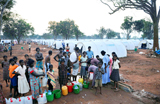Government troops have entered a “safety zone” that had been demarcated for civilians fleeing the rebel-held area in northeastern Sri Lanka, in a move aimed at rescuing civilians trapped in the fighting, a government minister said yesterday.
Defense spokesman and Minister Keheliya Rambukwella told reporters that troops had entered the safety zone amid resistance from the rebels of the Liberation Tigers of Tamil Eelam (LTTE) yesterday.
The safety zone, which is around 3km², was readjusted by the government on Friday and is part of a 6km² area along the coast in the north-eastern Mullaitivu district, which the rebels are holding.

PHOTO: AFP
In the latest operations, some 90 more civilians were rescued by the military yesterday.
Military spokesman Brigadier Udaya Nanayakkara said that troops advancing from two fronts toward the safety zone met with resistance but killed 25 rebels in one location and 10 more in another.
He said the rebels set off three suicide explosions as well.
The spokesman did not comment on military casualties.
The fresh moves came amid reports that over 400 civilians were killed over the weekend in the region.
The military and the LTTE have traded allegations as to who was responsible for the killing of the civilians.
UN Secretary-General Ban Ki-moon has called on the government and Tamil rebels to avoid further civilian casualties in the conflict in the north of the country.
“The secretary-general is appalled at the killing of hundreds of civilians in Sri Lanka over the weekend,” a statement from his office said.
“The secretary-general urges the government of Sri Lanka to explore all possible options to bring the conflict to an end without further bloodshed and to make public the terms under which that can be achieved without further loss of civilian life and for the LTTE to give sober and positive consideration of those terms,” the statement said.
Earlier the government said it would not use heavy weapons in the operation which they say is aimed at rescuing some 20,000 civilians trapped in the area.
UN agencies said the number civilians in a narrow land strip along the coastal area of Mullaitivu, 395km northeast of the capital, was about 50,000.
The UN statement said the secretary-general has repeatedly called on both sides to stop using heavy caliber weapons in areas with high civilian concentrations.
The International Committee of the Red Cross (ICRC) has sent a ship with 30 tonnes of food for the civilians in the rebel-held area, but until noon the ship had not been able to get close to the coast for unloading because of the fighting, ICRC sources in Colombo said.
The ship is scheduled to carry back some of the injured and ill persons as they have been doing in the past. Doctors in the conflict zone say they lack medicine to treat the injured.
The number of wounded was estimated at more than 1,200 since the incident on Sunday.
Government troops say they are on the final phase of ending a major military operation aimed at crushing the rebels as well as rescuing civilians from the guerrilla control.

Former Nicaraguan president Violeta Chamorro, who brought peace to Nicaragua after years of war and was the first woman elected president in the Americas, died on Saturday at the age of 95, her family said. Chamorro, who ruled the poor Central American country from 1990 to 1997, “died in peace, surrounded by the affection and love of her children,” said a statement issued by her four children. As president, Chamorro ended a civil war that had raged for much of the 1980s as US-backed rebels known as the “Contras” fought the leftist Sandinista government. That conflict made Nicaragua one of

COMPETITION: The US and Russia make up about 90 percent of the world stockpile and are adding new versions, while China’s nuclear force is steadily rising, SIPRI said Most of the world’s nuclear-armed states continued to modernize their arsenals last year, setting the stage for a new nuclear arms race, the Stockholm International Peace Research Institute (SIPRI) said yesterday. Nuclear powers including the US and Russia — which account for about 90 percent of the world’s stockpile — had spent time last year “upgrading existing weapons and adding newer versions,” researchers said. Since the end of the Cold War, old warheads have generally been dismantled quicker than new ones have been deployed, resulting in a decrease in the overall number of warheads. However, SIPRI said that the trend was likely

BOMBARDMENT: Moscow sent more than 440 drones and 32 missiles, Volodymyr Zelenskiy said, in ‘one of the most terrifying strikes’ on the capital in recent months A nighttime Russian missile and drone bombardment of Ukraine killed at least 15 people and injured 116 while they slept in their homes, local officials said yesterday, with the main barrage centering on the capital, Kyiv. Kyiv City Military Administration head Tymur Tkachenko said 14 people were killed and 99 were injured as explosions echoed across the city for hours during the night. The bombardment demolished a nine-story residential building, destroying dozens of apartments. Emergency workers were at the scene to rescue people from under the rubble. Russia flung more than 440 drones and 32 missiles at Ukraine, Ukrainian President Volodymyr Zelenskiy

Indonesia’s Mount Lewotobi Laki-Laki yesterday erupted again with giant ash and smoke plumes after forcing evacuations of villages and flight cancelations, including to and from the resort island of Bali. Several eruptions sent ash up to 5km into the sky on Tuesday evening to yesterday afternoon. An eruption on Tuesday afternoon sent thick, gray clouds 10km into the sky that expanded into a mushroom-shaped ash cloud visible as much as 150km kilometers away. The eruption alert was raised on Tuesday to the highest level and the danger zone where people are recommended to leave was expanded to 8km from the crater. Officers also